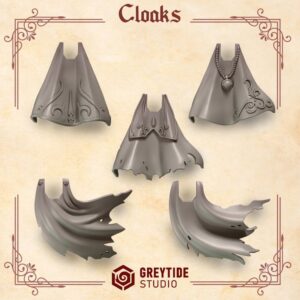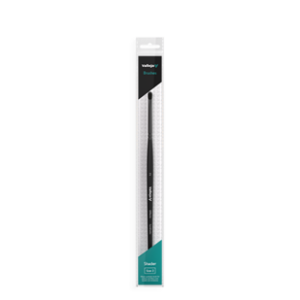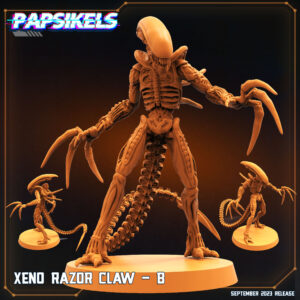Subtotal: 25,81 €
Alien Plants x8
Get eight Alien Plants Bits resin pieces for your miniatures.
Compatible with 25mm scale games. These pieces are printed in high-quality resin, making them perfect for painting. Their durability and fine detail make them ideal for miniatures and role-playing games. All our bits are printed with a 0.04mm resolution on 12k printers and have been thoroughly washed and cured after printing. Supports have been removed, but some additional cleaning may be required before painting, as well as assembly and gluing of certain parts. This product contains small parts that could pose a choking hazard and is not suitable for children under fourteen years old.
7,95 € 9,95 €
-
Bits & Parts, Scenery Materials, SciFi Bits
Alien Plants x8
Get eight Alien Plants Bits resin pieces for your miniatures.
Compatible with 25mm scale games. These pieces are printed in high-quality resin, making them perfect for painting. Their durability and fine detail make them ideal for miniatures and role-playing games. All our bits are printed with a 0.04mm resolution on 12k printers and have been thoroughly washed and cured after printing. Supports have been removed, but some additional cleaning may be required before painting, as well as assembly and gluing of certain parts. This product contains small parts that could pose a choking hazard and is not suitable for children under fourteen years old.
SKU: ADA000244 -
Spray Primers
Chaos Black Spray Paint
CHAOS BLACK PRIMER SPRAY PRODUCT DESCRIPTION
Chaos Black Spray is designed for basecoating plastic, resin and metal miniatures. Reformulated for maximum results, with a fantastic black colour.- Can be used as basecoat or undercoat
- 400ml spray can
- Comes with instruction for safe use
SKU: GW62-02 -
The Arrival of the Alien Resin Flora: A Tale of Discovery and Innovation
I can still remember the first time I saw them, the alien plants. It was unlike anything I had ever imagined. As a member of the Resin Armies community, I’ve seen my fair share of extraordinary 3D printed miniatures, but nothing compares to the breathtaking sight of these otherworldly resin bits. Our team, always looking for the next big innovation, never expected the plants to be more than just another project to test our printing limits. Yet, as we soon discovered, they were far more.
The day started like any other in our community. We were working on new designs, tweaking some old models, and sharing tips for perfecting the print quality of our miniatures. Resin Armies has always been known for its exceptional 3D printed miniatures, from miniature soldiers to creatures and terrain pieces. The focus was on precision, detail, and creating stunning models that could stand out on any tabletop. But little did we know, a new discovery was about to change everything.
The plants arrived as part of an unexpected delivery from one of our more adventurous members, a collector of rare materials. He had come across a shipment of alien resin fragments—bits of a strange, iridescent substance that, when handled, felt like nothing we’d encountered before. At first glance, the resin bits seemed harmless, just another batch of resin to be used in creating miniatures. But the moment we touched them, something felt… different.
We placed the first few pieces into our resin printers, eager to see what kind of models could be made from this new material. The results were incredible. The plants that formed from these resin bits were alive with detail—undulating vines, twisting tendrils, and leaves that shimmered with an iridescent glow. These weren’t just ordinary plants; they were alien, otherworldly creations with an almost organic feel, yet too precise and symmetrical to be completely natural. They seemed to grow in ways that no earthly plant could.
At first, we thought it was just a trick of the light. But the more we printed, the more we realized: these resin plants weren’t simply objects; they were mimicking life. They moved, shifted, and even seemed to respond to their environment. The first few miniatures we printed felt like they were alive, as if the resin itself had some sort of connection to the universe they came from.
As the months passed, our understanding of these alien resin bits grew. They were more than just a novelty; they had properties we couldn’t explain. The plant-like structures began to expand and mutate in strange and beautiful ways, forming interconnected ecosystems that looked more like living organisms than static models. We began experimenting with how they could interact with other miniatures, creating a new genre of terrain and plant-based creatures. These alien plants weren’t just part of a set of figurines; they became the very lifeblood of our 3D printed worlds.
The possibilities seemed endless. We saw potential for these resin plants in everything from dioramas to tabletop wargames. With their otherworldly look and feel, they could bring entire new dimensions to gameplay, offering everything from alien jungles to treacherous, overgrown battlefields. Imagine a player’s army fighting through dense foliage, where each leaf could be a hiding place for enemies or even trigger environmental hazards. These resin plants were adaptable, able to be combined with any miniature, whether it be for sci-fi, fantasy, or post-apocalyptic themes.
However, what intrigued me the most was the unexpected intelligence these alien resin bits seemed to exhibit. After a while, our group noticed that certain plants reacted to the changes in light and temperature. The resin structures would bend toward heat sources or change color under different wavelengths of light. Some of us began to wonder if these alien plants weren’t just a strange mix of resin and organic material, but possibly part of a broader, sentient network. Was it possible that these resin bits had come from a plant species that had evolved on another world to communicate or adapt in ways we couldn’t yet comprehend?
Our next steps became a delicate dance between exploration and caution. We couldn’t ignore the growing suspicion that these plants were more than just a novelty material for 3D printing. We weren’t scientists or botanists—we were a community of creators, designers, and gamers—but curiosity drove us. What could we learn from these alien resin plants? Could they reveal secrets about extraterrestrial life or even revolutionize our understanding of materials science? Perhaps, just perhaps, these plants were not as alien as they appeared, and we might unlock a piece of an ancient puzzle that bridged the gap between worlds.
One of our members, a bioengineer in their spare time, took the lead on experimenting with the plants in more controlled environments. We placed them in tanks where they could grow and evolve freely, observing how they adapted to different conditions. The results were staggering. The resin plants began to form more complex structures, almost like small, self-contained ecosystems. Some grew rapidly, while others stayed dormant until activated by specific stimuli. The most fascinating development came when we noticed that the resin plants seemed to produce a new type of resin—one that was more malleable, more adaptable to different printing conditions. This resin seemed to have a level of versatility that we had never experienced before, opening up even more possibilities for 3D printed miniatures.
We began crafting new models using this adaptive resin. The results were mind-blowing. The plants evolved into new forms: massive alien trees with twisting branches, vines that could be used as terrain pieces or even miniature props for games, and flowers that shimmered with vibrant colors. We even started experimenting with interactive miniatures, where the resin plants could respond to actions within a game, changing shape or triggering environmental effects as part of the gameplay. This wasn’t just about creating beautiful models—it was about creating an immersive experience for players, one that incorporated living elements into the gameplay itself.
As a community, we couldn’t help but wonder what these alien resin bits could mean for the future of 3D printing. Could we replicate these materials on a larger scale? What if we could create entire landscapes, filled with intricate alien flora, that could interact with miniature armies in real-time? The potential for innovation was enormous, and it was all made possible by these bizarre, alien resin plants.
In many ways, the alien plants were not just a new product for our 3D printing community; they were a breakthrough. A new frontier had opened up, and with it, the possibility of pushing the limits of what was possible in the world of miniature design and gaming. As we continued to work with these resin bits, we knew that we were witnessing something unique, something that would change the way people approached 3D printing for years to come.
Looking back, I can’t help but marvel at how a simple discovery turned into something so much more. These alien resin bits, once thought to be a novelty material, had become the heart of our creative efforts. The plants that we had once thought were simply interesting models now held the key to new possibilities in miniature gaming, 3D printing, and design. The future was uncertain, but one thing was clear: Resin Armies was at the forefront of something truly groundbreaking.
We continue to explore these resin plants, experimenting with new designs and innovations. Our community has grown, and with it, the world of 3D printing has become richer, more vibrant, and more full of life than ever before. The potential for new products, new designs, and new ways to play is limitless, all thanks to these strange, alien resin bits that we stumbled upon.
As we continue to unlock their secrets, we invite you to join us on this exciting journey. Whether you’re a seasoned 3D printing expert or a newcomer eager to explore the world of miniatures, there’s a place for you in the Resin Armies community. Together, we can create new worlds, new plants, and new experiences that will captivate and inspire for years to come.
Resin Armies, your 3D printed miniature store.
| brands | |
|---|---|
| Role |
Compatible with 28mm scale games. This miniature is printed in high quality resin perfect for painting. Its resistance and high definition make it ideal for miniatures and role-playing games. All our figures are printed with a resolution of 0,04mm 12k printers and have been smoothly washed and cured after printing. Additionally, all supports have been removed, although they may require some additional cleaning before painting, as well as assembly and gluing of certain parts. This product contains small parts that may cause choking and is not suitable for children under fourteen years of age.
You may also like…
-
Base Paints, Citadel, Paints
Base: Rakarth Flesh (12ml)
Citadel Base paints by Games Workshop are high quality acrylic paints specially formulated for basecoating your miniatures quickly and easily. They are designed to give a smooth matte finish over black or white undercoats with a single layer. All Citadel paints are non-toxic, water-based acrylic that are designed for use on plastic, metal, and resin miniatures. 12 ml of Rakarth Flesh.
SKU: GW21-27 -
Citadel, Layer Paints, Paints
Layer: White Scar (12ml)
Citadel Layer paints are high quality acrylic paints, and with 70 of them in the Citadel Paint range, you have a huge range of colours and tones to choose from when you paint your miniatures. They are designed to be used straight over Citadel Base paints (and each other) without any mixing. By using several layers you can create a rich, natural finish on your models that looks fantastic on the battlefield. This pot contains 12ml of White Scar, one of 70 Layer paints in the Citadel Paint range. As with all of our paints, it is a non-toxic, water-based acrylic paint designed for use on plastic, metal, and resin Citadel miniatures.
SKU: GW22-57 -
Miniature Holders, Accessories & Tools
Citadel Colour Painting Handle XL
The XL Citadel Colour Handle features a balanced and ergonomic base that comfortably fits in the palm of your hand, allowing for longer painting sessions with less effort. The large spring-loaded clamp securely holds bases, making it easy to work on your miniatures without hassle.
SKU: GW66-15 -
Spray Primers
Chaos Black Spray Paint
CHAOS BLACK PRIMER SPRAY PRODUCT DESCRIPTION
Chaos Black Spray is designed for basecoating plastic, resin and metal miniatures. Reformulated for maximum results, with a fantastic black colour.- Can be used as basecoat or undercoat
- 400ml spray can
- Comes with instruction for safe use
SKU: GW62-02


 Layer: White Scar (12ml)
Layer: White Scar (12ml)  Voodoo Dolls x3
Voodoo Dolls x3  Cloaks - Crimson Lords x5
Cloaks - Crimson Lords x5  Chaos Black Spray Paint
Chaos Black Spray Paint 


















